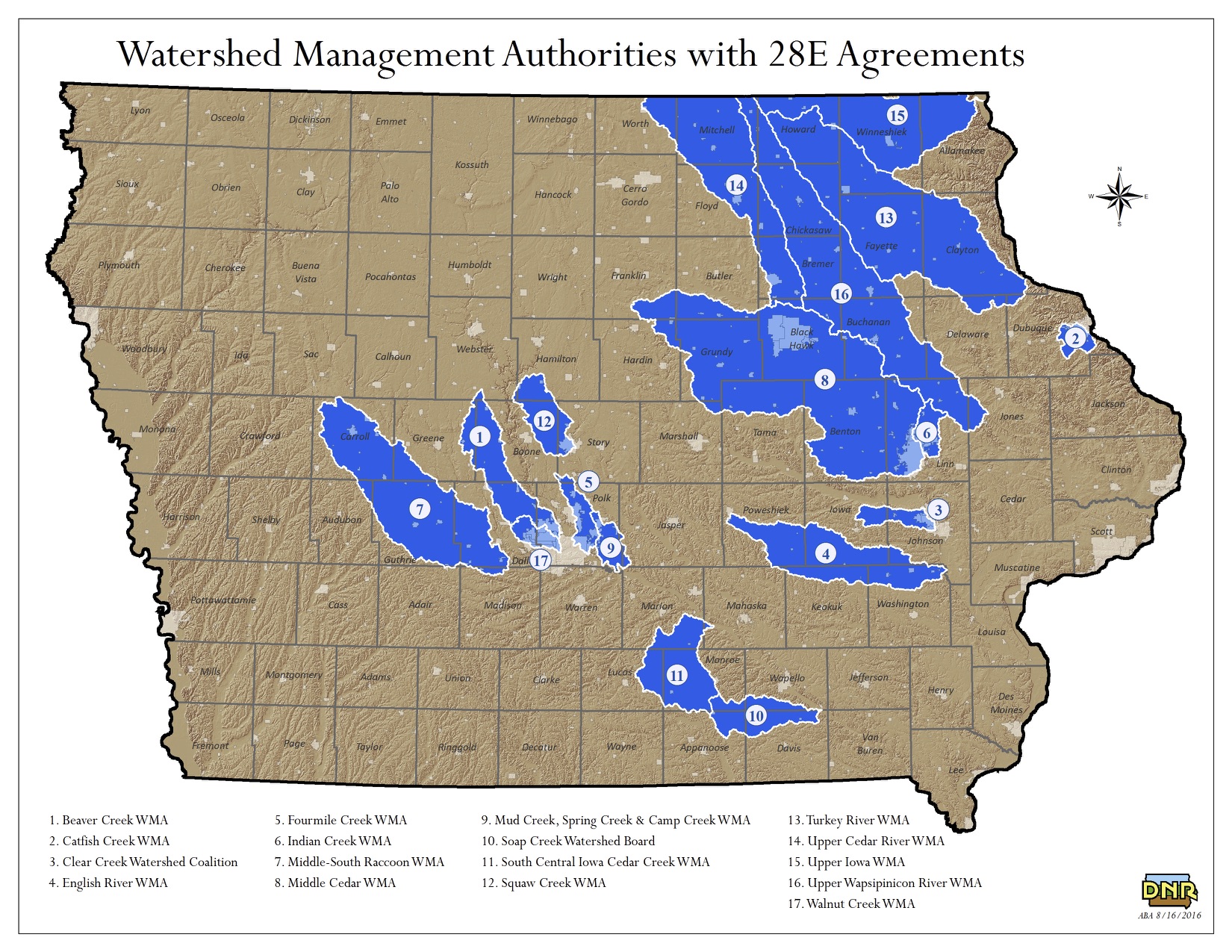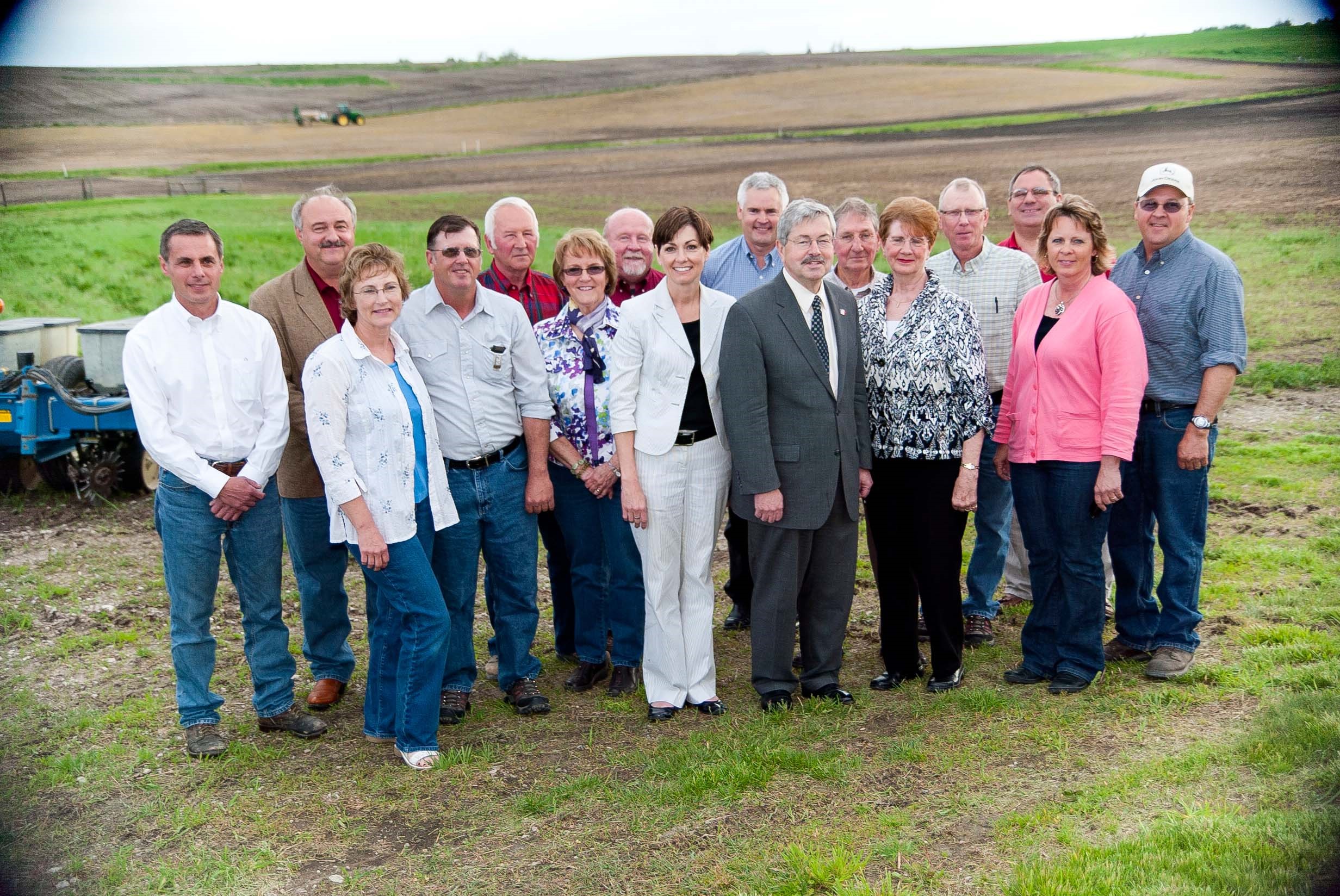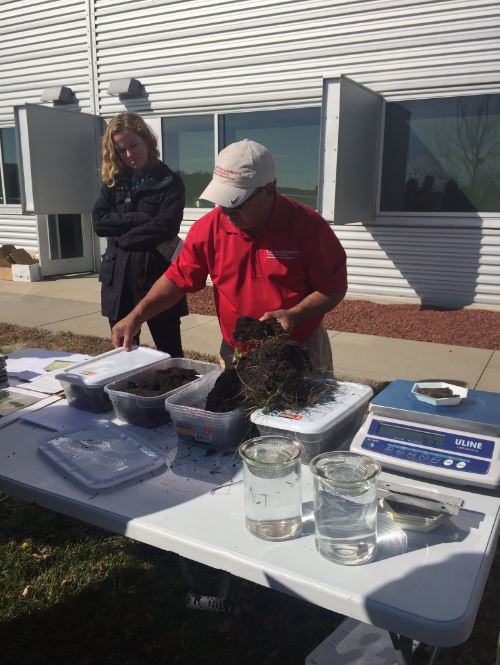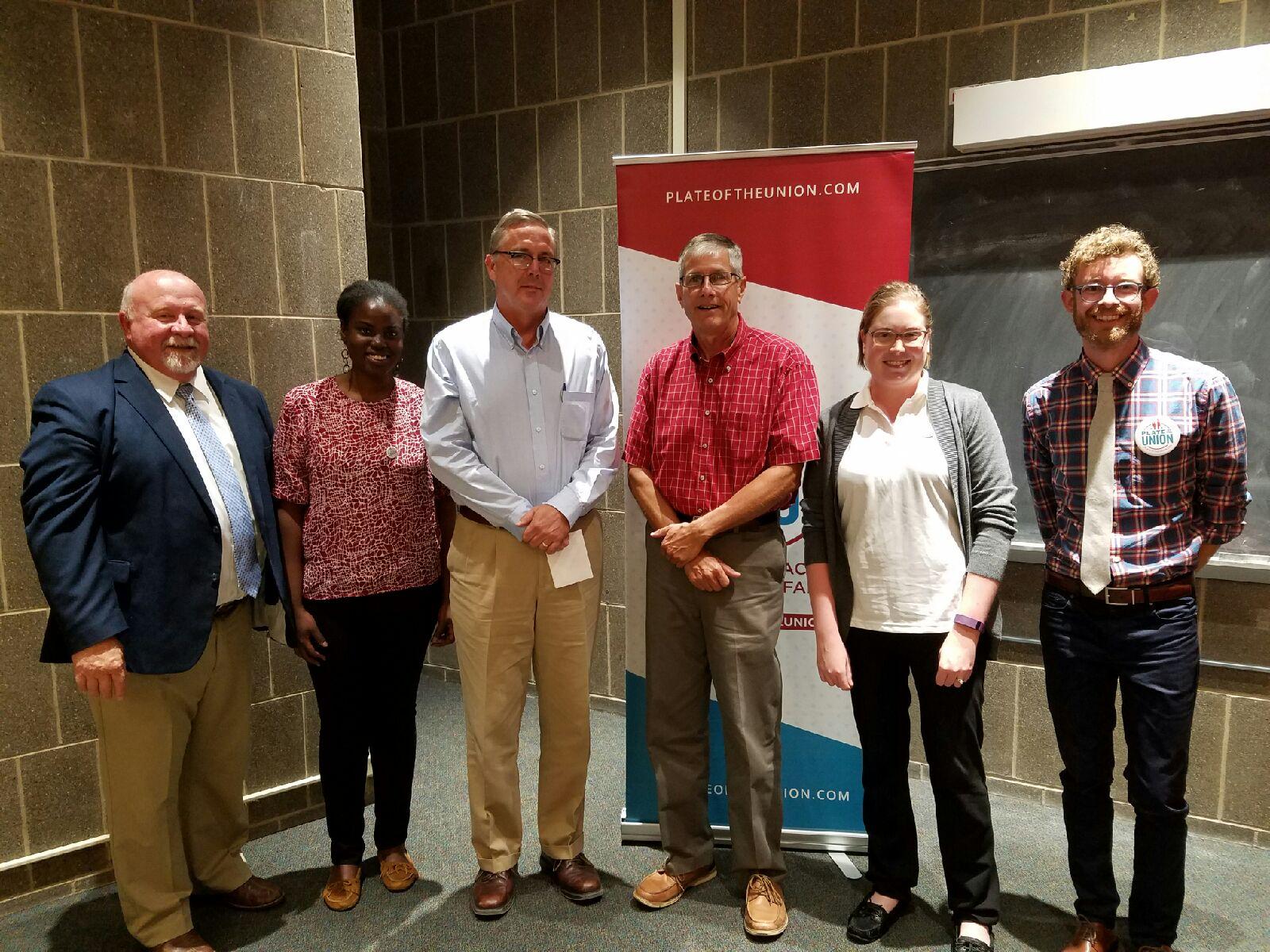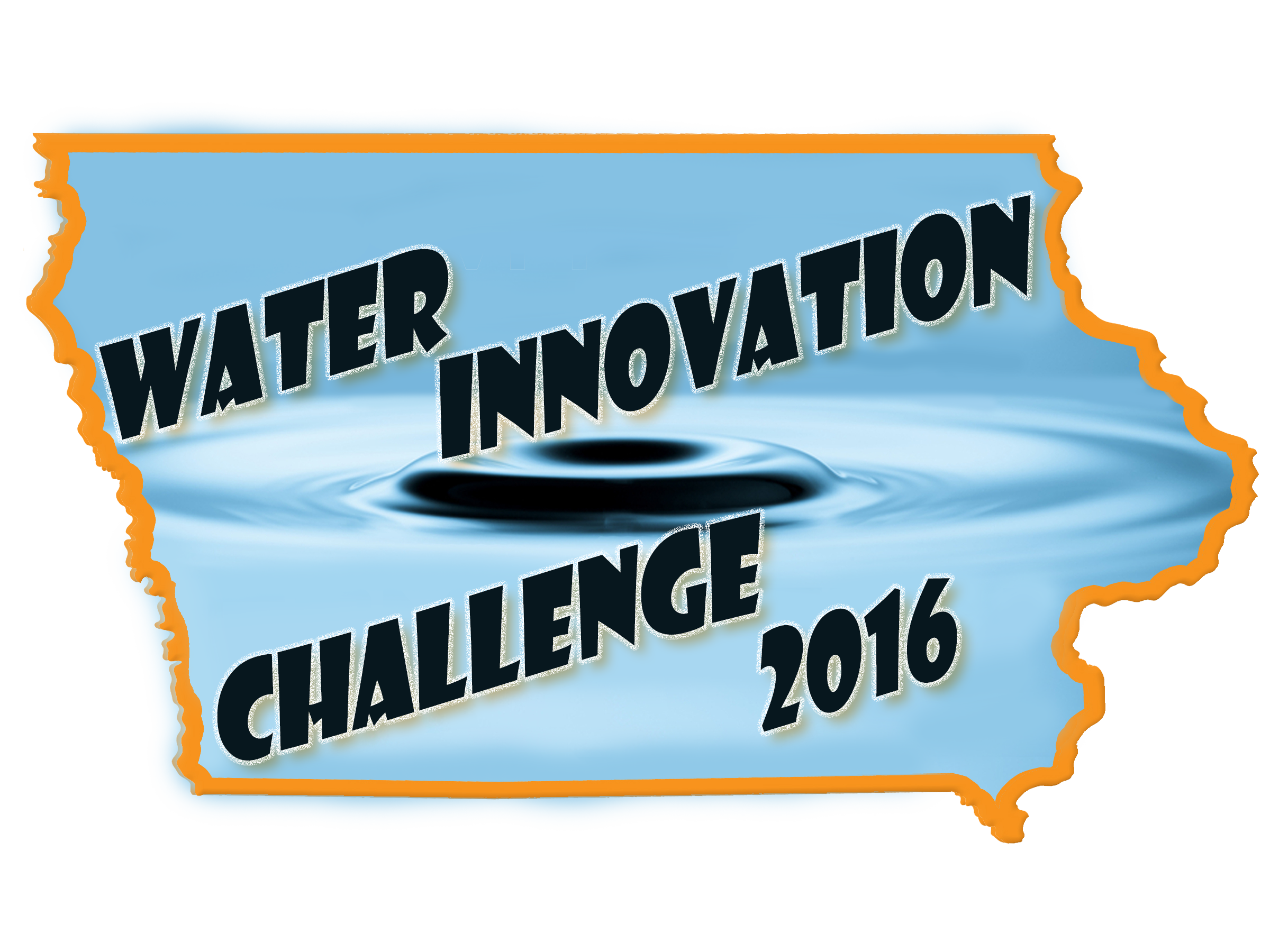The Boone River Watershed Nutrient Management Initiative project has been granted additional funding from Iowa Department of Agriculture and Land Stewardship (IDALS). This is in order to extend the project for another three years to increase the use of conservation and water quality practices in Prairie and Eagle Creek Watersheds. In these projects, we will continue working towards meeting Iowa’s Nutrient Reduction Strategy goals. The extension process involved writing a new grant application based on the lessons learned from our first three years.
Continue readingIowa Watershed Management Authorities: Notes from the Statewide WMA Meeting
Post submitted by Melissa Miller, Associate Director of the Iowa Water Center
At a recent Iowa Watershed Approach meeting, I introduced myself (half-jokingly) as the president of the Watershed Management Authority Fan Club. As evidenced by my post last fall after a trip to the Cedar River Watershed Coalition meeting, I am a strong supporter of a watershed approach to natural resource management. Naturally, Watershed Management Authorities (WMAs) are a recipient of my affection.
A brief overview for those not familiar with WMAs: Watershed Management Authorities are a state of Iowa-recognized mechanism for encouraging the collaboration of the different communities within a watershed and enacting watershed based planning, including adoption of conservation practices that mitigate flooding and improve water quality. WMAs were first introduced in Iowa in 2010 when Iowa code 466B was enacted. Major initiatives of this chapter include the formation of the Watershed Resources Coordinating Council (WRCC), Watershed Planning Action Committee (WPAC), the Water Quality Initiative (WQI), and WMAs. There are currently 17 WMAs in the state, with at least five more on deck for formation.
At a statewide WMA meeting on February 7, 2017, representatives from those WMAs gathered in Dubuque, Iowa to give updates and to talk strategy, successes, and collaboration. Mary Beth Stevenson with the Iowa Department of Natural Resources (IDNR) kicked off the afternoon with some fun facts about WMAs, including:
- 17 WMAs have received funding for planning or implementation through IDNR, Iowa Department of Ag and Land Stewardship, or the Iowa Watersheds Project or the Iowa Watershed Approach (two rounds of grant funding from the U.S. Dept. of Housing and Urban Development)
- 15 WMAs currently have funding at some level
- 10 WMAs are funded at a level with enough money for full-time staff and implementation
- 12 WMAs have or will have some level of paid staff, even if just part-time, funded locally and/or through grant funds
This is a promising start for WMAs as a successful vehicle for watershed management. Even more promising were the updates from the WMAs. Everyone had something to report from across the state. Indian Creek, one of the original six WMAs in 2012, is looking to hire a coordinator and completed an annual review that is turning into a strategic plan. Turkey River WMA, one of the “original HUD” projects succeeded in influencing policy in all participating political subdivisions (and achieved a 5% flood reduction in Otter Creek with the construction of 29 well-placed structures). In the Walnut Creek WMA a soil and water conservation district staff member found a lamprey (nearly extinct) in a CREP wetland. The Maquoketa River is also in the process of forming a WMA, not because they have outside funding, but simply because they have a group of interested citizens that recognize the benefits of working together.
These are just a few updates of many. My pen could hardly keep up and I couldn’t keep from asking questions. It is extremely energizing to be in a room full of people sharing ideas, concerns and solutions, and I wanted to learn all that I could. After the updates, Polk County WMA Coordinator John Swanson presented the unique activities happening in his part of the state (we will feature that presentation in its own post in the near future). We finished by breaking out into small groups to talk about how to keep WMA momentum going, establishing a WMA coordinator/staff position, watershed plan development and assessment, and how to structure a WMA collaborative group that communicates regularly to move all WMAs forward.
Citizen engagement is critical to the success of watershed management. I will leave you today with a challenge: find the WMA nearest you, even if you don’t live in that watershed, and attend a quarterly meeting. After you attend, you may just want to join my Watershed Management Authority Fan Club.
Introducing the Iowa Watershed Approach
The Iowa Watershed Approach (IWA) is a new five-year project focused on addressing factors associated with flood disasters in the state of Iowa. The IWA project will also provide benefits of improved water quality by implementing conservation practices outlined in the Iowa Nutrient Reduction Strategy.
Continue readingGet to know the Rathbun Land and Water Alliance
The Rathbun Land and Water Alliance was established in 1997 to promote cooperation between public and private sectors in an effort to protect land and water resources in the Rathbun Lake Watershed. The Rathbun Lake Watershed is located in the six southern Iowa Counties of Appanoose, Clarke, Decatur, Lucas, Monroe, and Wayne and covers 354,000 acres. Rathbun Lake is the primary water source for Rathbun Regional Water Association, which provides drinking water to 80,000 people in southern Iowa and northern Missouri.
Continue reading2016 Fall Watershed Academy
A few weeks ago, approximately 70 Iowa-based water professionals came together for the Watershed Academy. This two-day event was co-organized by Iowa State University Extension & Outreach, Conservation Districts of Iowa, the Soil and Water Conservation Society, Iowa Department of Agriculture and Land Stewardship, and the Natural Resources Conservation Service. The Academy sought to provide the latest information on conservation practices and educational resources.
Continue readingPlate of the Union Water Quality Panel Discussion
This year, the Iowa State University Sustainable Agriculture Student Association (SASA) received a national grant from the Plate of the Union Campus Challenge. Part of this sponsorship included hosting a panel on water quality issues
Continue readingPartnering with States to Cut Nutrient Pollution
By Joel Beauvais; originally posted on EPA Connect, the Official Blog of the EPA Leadership.
Nutrient pollution remains one of America’s most widespread and costly environmental and public health challenges, threatening the prosperity and quality of life of communities across the nation. Over the last 50 years, the amount of excess nitrogen and phosphorus in our waterways has steadily increased, impacting water quality, feeding harmful algal blooms, and affecting drinking water sources. From the Lake Erie algae blooms to the Gulf of Mexico dead zone, nutrient pollution is impacting every corner of our country and economy.
In 2011, EPA urged a renewed emphasis on partnering with the states and key stakeholders to accelerate the reduction of nitrogen and phosphorus pollution through state nutrient load reduction frameworks that included taking action in priority watersheds while developing long-term measures to require nutrient reductions from both point and non-point sources. Many states and communities have stepped up and taken action, supported with EPA financial and technical assistance. States have worked with partners to reduce excess nutrients and achieve state water quality standards in over 60 waterways, leaving nearly 80,000 acres of lakes and ponds and more than 900 miles of rivers and streams cleaner and healthier. And, in the Chesapeake Bay region, more than 470 wastewater treatment plants have reduced their discharges of nitrogen by 57 percent and phosphorus discharges by 75 percent.
We’ve made good progress but this growing challenge demands all hands on deck nationwide. Recent events such as the algae bloom in the St. Lucie Estuary in Florida and high nitrate levels in drinking water in Ohio and Wisconsin tell us we need to do more and do it now.
That’s why I signed a memorandum that asks states to intensify their efforts on making sustained progress on reducing nutrient pollution. EPA will continue to support states with financial and technical assistance as they work with their local agricultural community, watershed protection groups, water utilities, landowners, and municipalities to develop nutrient reduction strategies tailored to their unique set of challenges and opportunities. Partnerships with USDA and the private sector – for example the Regional Conservation Partnership Program (RCPP) projects in Cedar Rapids, Iowa, and more efficient fertilizer use on sensitive lands such as in the Maumee River basin in Ohio – are yielding more rapid nutrient reductions in areas most susceptible to the effects of nutrient pollution. Private sector partnerships that engage the power of the food supply chain, such as the Midwest Row Crop Collaborative Exit, hold much promise too. Innovative permitting solutions are driving improvements. For example, Boise, Idaho’s wastewater treatment plant permit that allows them to meet their nutrient limits in part by treating and reducing phosphorus in agricultural return flow in the nearby Dixie Drain at less cost to the taxpayers. These examples and others show us that states, in cooperation with federal agencies and the private sector, can drive nutrient reduction actions.
To help states make further immediate progress, this year EPA will provide an additional $600,000 of support for states and tribal nutrient reduction projects that promise near-term, measurable nutrient load reductions. This assistance will focus on public health threats from nitrate pollution in drinking water sources and harmful algal blooms in recreational waters and reservoirs.
With continued collaboration and partnership, I am confident we will make greater and quicker progress on achieving significant and measurable near-term reductions in nitrogen and phosphorus pollution. In turn, we will support a more vibrant economy and improve public health for all.
Read more about EPA efforts to reduce nutrient pollution.
Mixing entrepreneurs with H2O for a solution
Earlier this year, IWC Director Rick Cruse and Associate Director Melissa Miller met with staff from the Agricultural Entrepreneurship Initiative (AEI) at Iowa State University about an exciting new event idea. AEI team members have spent the last several months working tirelessly to organize Water Innovation Challenge 2016, an open community creative event that will join students, industry experts, scientists, entrepreneurs and YOU to collaborate and co-create new ideas that change the way we think about, manage, and use water in our state.
Details:
Waterpalooza 2016
Sept 1 & 2 (must be present both days)
Scheman Building, Iowa State University campus, Ames
$50 registration (FREE for current students)
Over $15,000 awarded in prizes
The event is facilitated by Dr. Jeffrey Stamp, a professional creative and concept developer who was the inventor of the Frito-Lay Baked! Lays® Potato Crisps. Dr. Stamp is a native of Sheldon, Iowa and leads creative innovation sessions worldwide for corporations, universities, and start-ups.
We at IWC are delighted to promote this event that will equip a variety of stakeholder with entrepreneurial skills all while thinking big and sharing ideas that will creatively address water quality issues in Iowa.
For guidelines, event schedule, and registration information, please visit the event’s webpage. Questions can be directed to Amanda Blair at acblair@iastate.edu or 515.294.4945. This event is sponsored by the Iowa Farm Bureau Federation.
Waxing poetic about working together (and NIWR)
In the water world, we talk a lot about working together. We all live in a watershed. The importance of partnerships. Work with your upstream neighbor to improve life downstream.
Sometimes, all it is, is talk. We say we want to work together, but it doesn’t happen, for whatever reason – maybe we can’t get together, we get busy with other things, we can’t agree on priorities. But the reason we talk about working together in water is because we do all live in a watershed. Working with your upstream neighbor DOES improve life downstream. Partnerships aren’t only important, they’re vital to success, and when we work together, impactful things happen.
Last week, 49 of the 54 Water Resources Research Institutes got together for the annual director’s meeting. The Virginia Water Resources Research Center planned the meeting this year (we had the honor last year) and for three days, we worked together.
A few droplets that represent the bigger “working together” stream:
-49 out of 54 WRRIs were in attendance. The meeting was in Washington, DC. The Virgin Islands made it. Alaska made it. Even Guam made it. (Actually, Guam director Shahram Khosrowpanah is a valued member of the NIWR board.) Distance didn’t preclude the Institutes from getting together.
-We heard from federal representatives that told us water resources research is headed toward the funding of collaborative, interdisciplinary research – multifaceted projects that address water resources not just from a technical perspective but also from a human dimension perspective. Water resources management IS the proverbial Big Picture. Research will treat it as such.
-Over a period of 24 hours, the Iowa, Illinois, and Tennessee Institutes went from chatting over a few sandwiches about potentially working on a regional effort to planning, identifying, and putting into action a plan to work with USGS Water Science Centers in our state and region to focus on making a difference in the Mississippi River basin. (More on that as it develops.) All three states have different priorities and run their Institutes a little differently, but we all have one goal.
This meeting was, and always is, a short period of time in which we focus on what it means to work together. Iowans, you have an opportunity to do the same thing next month at the Iowa Water Conference. Use the conference to not only learn about the latest in water management in Iowa, but to find people and organizations with whom you can work together. Work with your upstream neighbor; you WILL improve downstream. Partnerships ARE important. And for goodness sake, we all live in a watershed!
Iowa Water Conference preview – Dec 3, 9-10:30
If you’re going to be in Ames the morning of Thursday, December 3, please stop by the 2nd floor of Agronomy Hall from 9-10:30 a.m. The Iowa Water Center will host a poster session featuring the Ames High School Bluestem Institute students and their Project Localize water quality posters (yes, the same ones that will be at our special event in March!).
Come for the coffee and donuts, stay for these incredible posters. Instructors Chad Zmolek, Mike Todd, and Joe Brekke are preparing their students for their presentation at the Iowa Water Conference in March, where the students will partake in a breakout session entitled “Water in Iowa: Voicing the Lexicon” followed by a break where they will exhibit their posters. (Not to mention the gallery session at CY Stephens the evening of March 23!)
If that’s not enough to entice you (as if coffee and donuts didn’t get you hooked in the first place), we will also hand out copies of the full 2016 Iowa Water Conference agendas. This is an exclusive sneak peek into the program for 2016 – the full agenda will be released on the Iowa Water Center website on Friday, December 4, and the Iowa Water Conference website will be updated soon thereafter.
This is an exciting time for water in Iowa – we hope you’ll join us!
